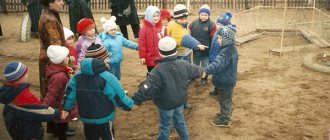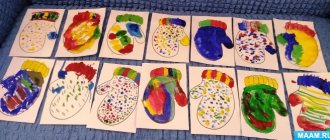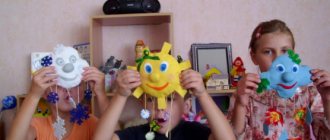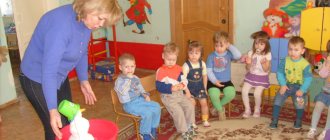SanPIN for swimming pools. Visiting rules and regulations for children: what should the water temperature be? Swimming equipment for the pool.
In this article we will talk about a swimming pool in a kindergarten and consider its healing effect on children.
We will provide detailed descriptions of the hygiene requirements for the pool and adjacent premises, and tell you about the functions of the maintenance personnel described in SanPiN. We will also separately discuss the safety of children and the things necessary for visiting the pool. A pond in a kindergarten has specific differences from a public one: everything must be designed for children, and their interests and characteristics must be taken into account. Children's institutions are subject to the most stringent requirements for hygiene and sanitary standards so that staying in the water is absolutely safe and brings only benefits. In this article we will look at some aspects and features of swimming pools in kindergartens.
The healing effect of swimming on a child’s body
The benefits of swimming in a pool for the harmonious development and health of a child have been proven many times. Exercises in water help develop and strengthen the muscular corset and correct posture, and rhythmic breathing helps prevent viral respiratory diseases. Swimming is also one of the least traumatic sports, since the body is completely supported by water, and the load is distributed evenly across all muscle groups. Improving blood circulation during exercise helps to increase brain activity.
Swimming combines both work and relaxation, so the muscles, by tensing and then stretching, become stronger and stronger, but do not increase in volume. Children's activities in the pool cannot cause harm, because they are even used in the rehabilitation of patients.
During the classes, children are taught not only different swimming styles, but also diving in the pool, which helps improve lung function, coordination, and develop the skill of exhaling under water. Proper breathing also helps saturate brain cells with oxygen. By playing in a pond, children can release excess energy, and the waves of water that support the body, like a massage, will relax, calm and relieve the child from hyperactivity for a while.
In addition to the positive effect on general health, playing in water improves the emotional and psychological state of the child.
How to overcome your fear of water
It often happens that children are very afraid of water. In such cases, not only swimming in the pool becomes a problem, but also banal bath procedures. You need to get rid of this as early as possible.
Child in a cap in the pool
There are several ways:
- It is worth choosing a moment when the child is in a good mood. Take the baby in your arms and slowly lower him into water at a comfortable temperature. In this case, you need to talk to him. Demonstrate in every possible way that the adult is not bothered by what is happening now. Take a bright toy and let him swim with it. You should not expect immediate results, but over time the child will be able to safely tolerate bathing. He even loves water.
- Many parents, seeing that their child is afraid to swim, take a bath with him. There's nothing wrong with that. Children feel confident around their parents. Innovations are more easily accepted, again, toys. Distracted by them, the baby loses sight of the fact that he is in a wet space. Obviously does not feel any discomfort from the water.
- If the sight of water causes hysterics, it is better to use the gradual habituation method. Start bathing in the basin. Wet your eyes and head while playing. When bathing is no longer accompanied by hysterics, you can move on to the bath.
- The brain of a small child is designed in such a way that all events quickly disappear from memory. Based on this, any fright during swimming (swallowed water, fell sharply into the water) can be smoothed out by taking a break from swimming for several days. Unpleasant memories will go away, and the baby will happily splash around in the bath again. If the child continues to cry, you should change the bathing location. For example, take the baby bath to another room.
- It happens that a child tolerated water well, but as a result of circumstances began to be afraid to dive into it. Here you need to start drawing some water into the bath. Gradually add and use distractions (bath foam, wind-up water toys). The desire to play will dull the fear, and soon the bathing process will improve.
Objectives and goals of physical education
Note! Until a child overcomes his fear of water, there can be no talk of learning to swim.
SanPiN requirements for children's pools
SanPiN (Sanitary and Epidemiological Rules and Standards) are a fundamental set of rules for organizing a swimming pool. This document contains all instructions, requirements and standards that must be strictly and fully observed. Let's look at some of the most important of them.
So, what must be near the pool?
- 2 changing rooms;
- Spacious hall with a pond;
- Showers, toilets;
- Nurse's office and swim coach's room;
- Premises containing the technical equipment of the swimming pool;
- Laboratory for water analysis.
Now let's look at the roles and responsibilities of the people who must be present throughout the entire swimming lesson: the instructor and the nurse.
The physical education instructor (who teaches swimming in the pool) should ensure that children shower before they go into the pool and after class to rinse off the chlorine-containing water.
The nurse should examine children before each activity to check for skin irritation and illness. If children complain about their well-being, as stipulated by SanPiN, the nurse releases them from classes. She must be with the children during the entire lesson. The pool should have dimensions from 3 by 7 to 6 by 10 meters. The optimal water temperature is 30-32 degrees, children love warm water and are willing to play in it. The nurse monitors the children during classes, monitors the hygienic condition of the pool, equipment and all adjacent rooms, controls the temperature of the water and air, helps children wash and dress, and provides first aid if necessary.
SanPiN attaches great importance to measures for disinfection and disinfestation of the pool, how many times and how to take samples and analyzes of water, bacteria, etc. SanPiN also pays attention to water purity. Its complete replacement with constant circulation should be carried out within 8 hours. If there is no constant circulation, then the discharge and collection of water must be carried out daily, according to SanPiN. Cleaning the pool in a kindergarten must be carried out by special services or employees responsible for this operation.
According to SanPiN, the pool and adjacent rooms in a kindergarten can become centers of mass infection - fungal, adenoviral, parasitic infections. Therefore, treatment and disinfection must be carried out regularly and according to established rules. Shower and toilet rooms, locker rooms, and bench surfaces are subject to daily cleaning.
General cleaning of the pool is usually carried out once a month. Water quality control is carried out once a day, microclimate parameters - 2 times a year, air condition, noise and lighting levels - once a year, bacteriological and parasitological analyzes of the water surface - once a quarter. Interesting fact: The recommended time in the pool is adjusted based on the age of the children: junior group - 15-20 minutes, middle group - 20-25 minutes, senior and preparatory groups - 25-30 minutes.
In winter, classes in the pool should take place after a walk; if this is not possible, then at least 50 minutes should pass between swimming and walking.
Swimming classes in preschool pools are widely promoted as a powerful means of improving health and strengthening the body. However, in practice this is not confirmed, and the reason is very simple. The best temperature conditions for swimming in preschool swimming pools are regulated by the above methodological recommendations as air temperature 24–25°, water temperature – 23°. At the same time, as one of the leading domestic scientists Yu.F. points out. Zmanovsky, hardening in a pool is reproducible only at a sufficiently high (5–8° or more) temperature difference between water and air in the pool, when, due to its significantly greater heat capacity, the water is perceived as a cool douche. In his opinion, the best water temperature for swimming in the pool is 26–27°, the air temperature is 30–35°, and at higher air temperatures he even allows the water temperature in the pool to drop to 22–23°.
In the absence of the necessary temperature difference between water and air in the pool, children’s stay in it turns only into a sports procedure for learning to swim: in the preparatory part
– warm-up in the pool gallery, including several general developmental exercises to warm up the body in
the main part
– mastering swimming techniques and playing to improve the learned movements; in the final stage - free swimming.
The duration of the lesson in the pool is determined by the child’s behavior: as soon as a slight chill appears, attention weakens, you need to take a break, rub the baby’s body with a towel and put warm clothes on him.
Rubbing is a kind of heating. Rubbing increases skin temperature by 2–4°C or more compared to the initial one. This increases the rate of thermal recovery processes and reduces the effect of cold hardening. Therefore, rubbing and self-massage after cold exposure is only a choice necessary to urgently stop the cooling process of the body,
but not the end of the effect of cold on the body, as was believed until recently.
Classes in the swimming pool (“paddling pool”) begin with the 2nd junior group of kindergarten. The sports part of the activity for young and middle-aged children consists mainly of mastering the water element and becoming familiar with the properties of water. This part of the classes is full of playful elements that are perfectly perceived by children. This includes actively dousing children, immersing them in water at various levels, and performing breathing exercises in water. These lessons, with their proper organization and the active participation of the instructor-methodologist, create an ideal physical education and health complex.
Typically, the first sessions in the pool should not exceed 7–8 minutes, gradually they can be increased to 15–20 minutes. Due to the fact that children freeze faster than adults due to the peculiarities of their thermoregulation, and wet clothes additionally take away heat, it is better to allow preschoolers to practice in water without clothes, as is customary, for example, in Germany.
The water level in the pool for the 2nd junior group is adjusted from 20–25 cm to 60–70 cm depending on the content of the lesson, and in the senior group starting to learn swimming – up to 90 cm.
Children's classes in the pool should be carried out in the first half of the day from 9 to 12 o'clock or in the afternoon from 15 to 18 o'clock. The duration of the procedure in the junior group is 20-2 5 minutes, in the middle and senior groups - 25-35 minutes, in the preparatory group - 35–40 min. This duration is optimal and does not tire the child.
Classes in the pool in the first half of the day can be held instead of the third physical education lesson, which is organized during a walk, and also by moving some classes (modeling, drawing, reading fairy tales) to the second half of the day. In cases where the walk is shortened, it is necessary to compensate for the time children spend outdoors. This can be done by taking them in the morning at the site and organizing a longer walk in the afternoon.
BC Rychkova describes the contrast shower
children
when taking a hygienic shower in front of the pool.
After a dry warm-up, children begin to wash themselves under running water at the same temperature as in the pool, and wash off the soap with water whose temperature is 3–5° lower. After swimming, the shower temperature is first 3–5° higher, and then the same as in the pool, or 3–5° lower.
Traditional method of hardening while swimming in the pool.
It is best to start your first sessions in the pool at a water temperature of no more than 26–27°, and at the same or slightly higher air temperature – 29–30°.
Then, every 2–3 weeks, it is necessary to gradually reduce the water temperature in the pool by 1°, bringing it to 20–21°, and at the same time gradually reduce the air temperature in the pool to 23–24°, and for hardened children – even to 20–21°. The basic rule is that the air temperature should be 2–3° higher than the water.
When the water temperature is below 19°, swimming lessons should not be held, but in older groups they can be replaced by a short swim followed by a hot shower.
An original system for hardening children while bathing
in the pool (swimming training is carried out only in the last year of stay in a preschool educational institution) was proposed by S.A. Neustroev. It is based on a contrasting water shower at the game stages (cool water flows from the showers along the pool) and at the final stage (Charcot shower with a temperature of 5° and below, against the backdrop of a water temperature in the pool of 34–36°). The lesson uses underwater games, taking into account the health and physical fitness of the child.
A new approach to pool hardening
. Analysis of materials on the organization of hardening of children in the swimming pool of a preschool educational institution made it possible to theoretically substantiate a fundamentally new approach to normalizing thermal loads on children in the pool.
The methodological literature has already substantiated the same temperature regime of air and water in the pool when teaching swimming. In this case, there are no irritating thermal sensations that distract children from the educational process, but it is emphasized that such a regime cannot be hardening due to the absence of irritating thermal sensations, therefore temperature regimes with a difference in water and air temperatures of 2–3° (traditional) and 5-10° (according to Yu.F. Zmanovsky). With such a temperature difference, colder water (from 26–27° to 23–25°) compared to air (30–35°) is perceived as a cool douche. This method raises a number of objections in our opinion. We believe that:
• maintaining the air temperature in the pool at 30–35° is not easy, since the large surface of colder water intensively cools it;
• children entering into cool water is associated with unpleasant sensations;
• prolonged exposure to cool water with insufficiently intense muscle load (which is not always possible to obtain in children) threatens their rapid hypothermia, since the warming ability of air is lower than the cooling ability of water;
• when cooling occurs, warmer air has a warming effect only on the upper part of the body, and this warming with air is slower than with water. Therefore, even an urgent exit from the water does not save the child from hypothermia and requires an urgent hot shower or rubbing, which disrupts the lesson schedule.
It is necessary to swap the thermal regime of air and water in the pool:
• The water temperature in the pool should be maintained at a constant warm (35–40°) level. This is much easier than maintaining the air temperature.
• The temperature contrast between water and air, which is a necessary condition for hardening, is maintained by changing the air temperature in the pool, by periodically ventilating it before classes. In winter, it is easy to bring it to the required temperature in a short period of time. Ventilation should be completed 10–15 minutes before the start of the lesson so that the air temperature in the room is equalized. In the initial hardening mode, the air temperature should be 29–30°, with a gradual decrease every 2 weeks by 1–2° and bringing it to 23–24°, and for hardened children – to 20–21°. This air temperature is easily achieved by conventional heating systems, with the active help of a warm water surface.
• Aeration of the room further increases the purity of the air and enriches it with oxygen.
• A warm pool is more easily tolerated in colder air conditions, and not vice versa. A child who feels a chill always has the opportunity not only to take refuge in the warm water of the pool, but also to quickly warm up in it.
In the summer, hardening in the pool should be carried out according to the traditional scheme
(
colder water - warmer air, and in winter - according to the modified scheme we proposed
(
warmer water - colder air
).
Swimming in children's educational institutions has become very popular primarily because it has become possible to effectively harden children. Methodological literature, reflecting the issues of teaching children to swim, only briefly stipulates the conduct of hardening procedures in the pool. The emphasis in it is shifted to the sports, rather than the general health, side of activities in preschool swimming pools. Of course, it is important to teach children to swim, but we should not forget about the great health-improving potential of the kindergarten pool.
Swimming lessons in kindergarten
Before a lesson with children, you need to give a brief instruction on behavior in water: carefully monitor the physical education instructor and follow his instructions, under no circumstances run or make noise, and if you feel unwell, immediately report it.
The next stage: children must wash themselves in the shower so that dust and any other contaminants do not get into the pool. If necessary, teachers, instructor and nurse can help.
In order for your child to be allowed into the pool, you need to prepare the following things:
- One-piece swimsuit for girls, swimming trunks for boys;
- Long robe with hood;
- Several towels;
- Soap;
- Swimming glasses;
- Swimming cap and rubber shoes.
After each lesson, things must be taken home to be washed and dried.
The lesson begins with a short physical warm-up on land, during which children must warm up and warm up their muscles for further work in the water. This is a necessary stage, because if we immediately go into the water without warming up, we will not achieve the desired healing effect.
In the water of the pool, children follow the instructions of the instructor teaching any style of swimming, and immediately practice the acquired skills. After training, games begin, which children really like and bring a lot of positive emotions.
The final part of a swimming lesson in kindergarten is free swimming, when children simply frolic in the water, without any task.
Children's safety in the pool
A physical education instructor, a nurse and, in some cases, educators closely monitor the physical education instructor to ensure that nothing happens to the children during the lesson.
Since children must take a shower before going to the pool, the cabins must be equipped with anti-slip mats, which makes it completely safe for children to stay there.
Some groups practice a technique such as using inflatable arm sleeves, this will make it much easier and safer for children to float on the water.
It is imperative to explain to children that they cannot run near the pool, as they can slip and fall. The tiles that line the pool are also dangerous; they can cause cuts, for example, if children jump from the sides of the pool into the water without using a ladder. You need to talk to your children about all the dangers, which will help protect them from possible injuries.
Exercises for children
Swimming pool activities for children are divided into two groups:
- in water;
- on the land.
Pool exercises
In water
Exercises in the pool:
- Inhale, holding your breath as much as possible.
- Pull your knees towards your chest. Tilt your head closer to your knees. When performing this exercise, the water pushes the person's back up. The goal is to hold this position for as long as possible.
- Breathe. Lie with your back on the water. Spread your legs and arms in a star shape. Relax. Breathe evenly. At the slightest panic, the body begins to drown. The goal is to learn to control fear.
- Breathe. Turn face down in the water. Hold the breath. Relax. Move your arms and legs while doing this.
- Raise your hands up. Exhalation. Push off from the bottom and jump as high as possible. Dive.
Exercises on dry land
Land swimming exercises for children are not much different from adults. Of course, height, weight and age are taken into account, but the methodology is the same. It all comes down to simulating swimming movements on the shore. First of all, charging. To warm up your muscles you will need to do the following:
- Sit on the floor or bench. Sometimes performed while sitting on the edge of the pool. Stretch your legs in front of you and lift them. The feet are easily turned inward. Simulates the movement of legs in water. During swimming, your legs bend, but on the shore it is important to keep them straight at all times. This trains the entire leg muscle group.
- They lie down on the floor. Turn on their side. The hand on the floor extends upward. The second is pressed to the body. Small swings are made with the legs; they cannot be rubbed against each other; they should be moved as when swimming in the crawl style. You need to load your legs as much as possible and keep your body motionless.
- Children lie on the floor on their stomachs. The arms are extended forward. Only the legs move. A small range of motion is encouraged. It is better to place a towel under your feet to avoid injury to your feet.
On a note! Such exercises will help you master the crawl, breaststroke, and butterfly.
Infrared cabin after swimming
In some children's institutions, after the pool and shower, children are invited to warm up in the infrared sauna to avoid colds.
Is this the same as an infrared sauna? Most often, the cabin is made of natural wood and heating elements located around the entire perimeter, which allows for uniform heating, and to operate the sauna you only need a standard 220-volt outlet, which allows you to install this unit in any kindergarten. The temperature in the cabin is quite normal: 38-45 degrees, while in a regular bath or sauna it can reach up to 110, which is rather dangerous to health.
In winter, visiting an infrared sauna is especially useful for children, as it is equivalent to a full stay under the summer sun. The climate inside the cabin eliminates hot air, so children can breathe comfortably. Infrared waves warm the bodies of kindergarten visitors much better than the heat of a regular bath or sauna, where the air is quite heavy.
Also, an undoubted advantage of the infrared cabin is its ability to remove lactic acid from the muscles, which occurs after training. Of course, swimming lessons cannot be so intense that they cause muscle pain, but warming up is good for children anyway.
Individual lessons with an instructor
Individual swimming lessons for preschoolers have their advantages. The coach evaluates the child’s skills and brings them into line with the parents’ expectations. It is better to choose a children's pool and classes with a trainer.
Complexes of morning exercises for the senior group
Advantages:
- The training program is developed specifically for a specific child. All structural features of the body and the goals set are taken into account.
- The coach has complete control over the student. His task is to teach how to swim correctly and safely.
- Everything that a coach does for a child is aimed at obtaining a successful result.
- The lesson schedule can be easily modified to suit the specific needs of the student.
Equipment for the lesson
To make water activities in kindergarten productive and exciting for children, some sports and play materials are used:
- Foam strips;
- Balls;
- Ride-on toys;
- Diving toys;
- Inflatable rings.
Foam planks are used when learning to swim: for example, you need to hold the bar with your feet and stay afloat only with the help of your hands, or vice versa, make active movements with your legs while holding the foam with your hands. The purpose of this sports equipment in kindergarten classes is more educational than entertaining, but you can make the process more fun for children if you present the task as a game or use colored strips.
With the help of inflatable balls, you can perform many physical exercises and even games in the water, for example, children will love volleyball in the pool or a relay race where they exchange balls for speed.
Ride-on toys are suitable for little ones and those who don’t know how to swim yet. This equipment is an inflatable figurine of an animal or even a vehicle with a seating recess, in which holes are made for the legs and, thus, the child is held securely inside.
As the name suggests, diving toys are used to teach this very process. To make it interesting and not scary for your child to be under water, you can give him simple tasks, for example, touching a toy attached to the floor of the pool or picking it up. The most common and popular variety is toy algae. With their help, you can not only teach your child how to dive, but also give the pool a more picturesque look.
The function of the inflatable ring is to keep the child on the surface of the water. They are used for the very first lessons, when you are just getting acquainted with swimming.




